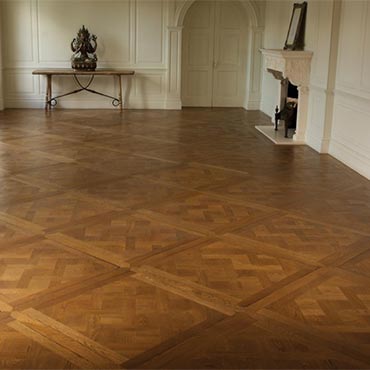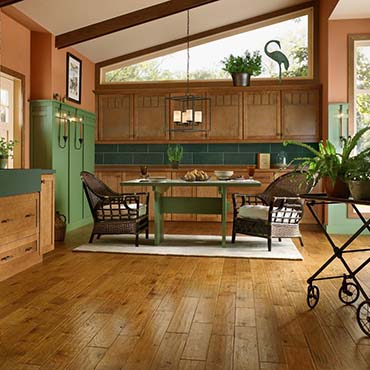Hartco Quality Wood Flooring, among the top flooring brands in the world, has a reputation among commercial designers for design freedom. Hartco's range and flexibility also satisfies a yearning for a highly personal, custom style in the home. Hartco patterns and contrasts help define interiors, from traditional to the avant-garde. Learn More
Parquet Flooring
Parquet Flooring Guide

Parquet Flooring: A Fusion of Tradition and Modernity in Architectural Design
Introduction
In the dynamic realm of modern architecture and interior design, parquet flooring stands out as a timeless yet innovative solution. Esteemed by architects, designers, and building contractors alike, its aesthetic versatility and sustainability make it a favored choice. This flooring technique, known for its geometric mosaic of wood pieces, dates back centuries yet continually adapts to contemporary design needs, offering both classic elegance and modern flair.
Types of Parquet Flooring
Parquet flooring, primarily celebrated for its diversity, comes in various wood types, each with its unique characteristics. These differences are not merely aesthetic but also functional, influencing the choice of material based on the architectural style and design theme.
- Oak Parquet: A staple in parquet flooring, oak offers a distinct grain pattern and a warm color spectrum. Its durability makes it suitable for both traditional and contemporary spaces. Oak's resilience also makes it ideal for high-traffic areas, though its reaction to high moisture levels needs consideration.
- Walnut Parquet: Renowned for its rich, deep hues, walnut parquet adds a luxurious touch to interiors. Its unique grain patterns provide a sense of depth, making it a popular choice for more opulent designs. However, walnut is softer than oak, making it less suitable for very high-traffic areas but perfect for residential settings.
- Maple Parquet: Maple, with its light color and subtle grain, offers a more modern, minimalist look. Its hardness is comparable to oak, making it a practical choice for various applications. However, its susceptibility to humidity changes requires careful consideration in areas with fluctuating moisture levels.
- Bamboo Parquet: Not a wood but a grass, bamboo offers an eco-friendlier alternative. Its rapid growth rate and sustainable harvesting practices appeal to environmentally conscious projects. Bamboo's hardness is variable but can rival traditional hardwoods, making it suitable for diverse environments.
Each type of wood brings its implications in terms of installation and durability. Oak and maple, with their hardness, are long-lasting and can withstand significant wear and tear, while walnut and bamboo, being softer, may require more frequent maintenance. The choice of wood type should align with the specific environmental conditions and traffic expectations of the space.
Sustainable Practices in Parquet Flooring
Sustainability in material choice is pivotal in contemporary building practices. Parquet flooring can be a sustainable option, especially when sourced from certified forests or made from reclaimed wood. The use of eco-friendly adhesives and finishes also contributes to this aspect, making parquet flooring a responsible choice for environmentally conscious projects.
Technological Advances
The evolution of parquet flooring is marked by technological advances, both in terms of finishes and installation techniques. Modern finishes not only enhance the durability and resistance of the wood to environmental factors but also offer a range of aesthetic choices, from matte to high gloss. Installation techniques have also evolved, with systems like click-lock making the process faster and less labor-intensive. These advancements allow for greater flexibility in design and application, catering to the diverse needs of modern architecture.
Conclusion
Parquet flooring, with its rich history and modern adaptations, offers architects, designers, and contractors an exceptional flooring solution that blends functionality with aesthetic appeal. The choice of wood type – whether oak, walnut, maple, or bamboo – should be made considering the specific needs of the space, including traffic, moisture levels, and overall design theme. Sustainability and technological advancements further enhance the appeal of parquet flooring, making it a smart choice for contemporary designs.
Incorporating parquet flooring into architectural and interior design projects not only pays homage to a time-honored art form but also embraces modernity, sustainability, and practicality. It’s a testament to the material's versatility and enduring appeal in creating spaces that are both beautiful and functional. As such, parquet flooring remains a cornerstone in the toolkit of professionals in architecture and design, seamlessly bridging the gap between tradition and innovation.
Disclaimer: The information provided in this article is for general informational purposes only. While we strive to ensure the accuracy and reliability of the information presented, we make no warranties, express or implied, about the completeness, accuracy, reliability, suitability, or availability with respect to the content. Any reliance you place on such information is strictly at your own risk. We recommend consulting with professionals for specific advice tailored to your project’s needs, particularly regarding building codes, regulations, and product specifications.
Under no circumstances shall we be liable for any loss or damage, including without limitation, indirect or consequential loss or damage, arising from the use of, or reliance on, the information provided in this article.
Select Product Sub-Category:
Parquet Flooring
Top 2 Types of Parquet Flooring
 Wood Flooring - 366 Prefinished Solid Parquet FlooringWith prefinished parquet flooring, the finish is applied at the manufacturer's facility. These parquet floors require less time to install because the sanding and finishing process has already happened. The parquet is ready to walk on immediately. | |
 Wood Flooring - 377 Unfinished Solid ParquetUnfinished Solid Parquet Flooring offers a unique blend of elegance and durability, allowing you to customize the finish to match your style, all while enjoying the timeless appeal of natural wood. |
Featured Brands
The Best 1 Parquet Flooring Brands

Hartco® Hardwood Flooring
Profile | Website | Install | FAQsHartco Quality Wood Flooring, among the top flooring brands in the world, has a reputation among commercial designers for design freedom. Hartco's range and flexibility also satisfies a yearning for a highly personal, custom style in the home. Hartco patterns and contrasts help define interiors, from traditional to the avant-garde. Learn More
Parquet Flooring Videos
The Top 1 Parquet Flooring Videos
Sanding and Refinishing Parquet Floors (whole process)
Parquet Flooring News
Latest Parquet Flooring News
Prefinished Solid Parquet Flooring...The Renaissance of Prefinished Solid Parquet Flooring in Modern Interior Design In the realm of modern interior design, prefinished solid parquet flooring has emerged as a pivotal element, intertwining elegance with practicality. This article delves into the myriad facets of prefinished solid wood parquet flooring, offering insights and guidance for interior designers, decorato... |
Prefinished Engineered Parquet...Prefinished Engineered Parquet Flooring: Transforming Modern Interior Design In the dynamic world of interior design, flooring plays a pivotal role in shaping the aesthetic and functional aspects of a space. Among the various options available, Prefinished Engineered Parquet Flooring has emerged as a popular choice, blending tradition with modernity. This flooring type not only... |
Unfinished Solid Parquet...Unveiling Elegance: The Renaissance of Unfinished Solid Parquet in Modern Design In the realm of modern interior design, Unfinished Solid Parquet Flooring stands as a testament to timeless elegance and versatile charm. This article delves into the essence of Unfinished Solid Parquet, exploring its types, species, and the myriad ways it transforms interior spaces, while contrast... |
Custom Wood Floors...yCustom wood floors can be adapted to suit any design vision. Whether it's the rustic charm of hand-scraped hardwood, the sleek appeal of high-gloss finishes, or the innovative patterns of parquet flooring, wood offers unparalleled versatility. Designers can mix and match different woods, finishes, and laying patterns (like herringbone or chevron) to create unique, eye-catching floors.<... |
Parquet Flooring...Parquet Flooring: Reviving Timeless Elegance in Modern Design In the realm of interior design, the choice of flooring plays a pivotal role in defining the ambiance and character of a space. Among the myriad of flooring options, Parquet Flooring stands out as a symbol of sophistication and timeless elegance, seamlessly blending into the narrative of modern interior design. This ... |
Hardwood Plank Flooring...n types include: Strip Flooring: Narrow, linear planks that create a uniform, elegant look. Plank Flooring: Wider planks that offer a more rustic, spacious feel. Parquet Flooring: A mosaic of wood pieces, creating geometric designs for a more decorative approach. Species of HardwoodThe species of wood used in plank flooring signi... |
Engineered Parquet Flooring...Engineered Parquet Flooring: The Modern Key to Timeless Elegance In the dynamic world of interior design, the quest for both beauty and practicality often leads to the embrace of engineered parquet flooring. This innovative flooring solution merges tradition with technology, offering an array of options to designers, decorators, and consultants. This article delves into the ess... |
